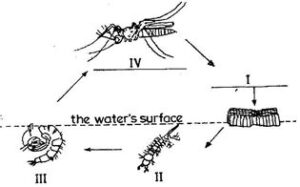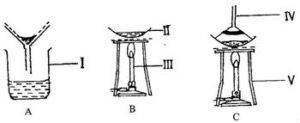JUNE 2019 SOCIAL STUDIES Paper 2 ESSAY This paper consists of three sections: I, II…
BECE 2014 Science Past Questions Paper 2 (Essay)
JUNE 2014
INTEGRATED SCIENCE 2
PAPER 1 – ESSAY
1 ¼ hours
PART I
[40 marks]
Answer all of Question 1
1. (a) The diagrams below represent the stages in the life cycle of a mosquito
Study the diagrams carefully and answer the questions that follow

(i) Name each of the stages labeled I, II, III and IV
(ii) State how stage II obtains oxygen
(iii) State two methods of controlling each of the stages labeled III and IV
(b) The diagrams below are different laboratory set-ups used in the separation of mixtures.
Study the diagrams carefully and answer the questions that follow

(i) Name each of the parts labeled I, II, III, IV and V.
(ii) Name the separation method represented by each diagram.
(iii) Which of the set-ups is used to obtain clear water from muddy water?
(iv) Which of the set-ups is used to obtain salt from salt solution?
(c) The diagrams below show some instruments used in the laboratory.
Study the diagrams carefully and answer the questions that follow

(i) Identify each of the instruments labeled I, II, III, IV and V
(ii) State one use of each of the instruments labeled I, II, III and IV
(iii) Read and record the volume of the liquid in the instrument labeled V
(d) The diagram below shows the digestive system of a class of farm animals.
Study the diagrams carefully and answer the questions that follow

(i) Name each of the parts labeled I, II, III and IV
(ii) State one function each of the parts labeled II and IV
(iii) Name two farm animals that possess this type of digestive system.
(iv) Mention two diseases which affect this class of farm animals.
[10 marks]
PART II
[60 marks]
Answer four questions only from this part.
2. (a) (i) Name the two elements that combine to form water.
(ii) Write a balanced chemical equation to show how the water is formed from the named elements
(b) State two ways of maintaining a balance in an ecosystem.
(c) (i) What is a fertile soil?
(ii) State two factors that cause loss of soil fertility.
(d) Classify the following items as magnetic or non-magnetic substance:
wood, steel blade, rubber and glass jar.
3. (a) (i) What is germination of seed?
(ii) State two conditions necessary for the germination of seed.
(b) State four methods used in identifying farm animals
(c) Explain why it is easier to cut a piece of yam with a sharp knife than with a blunt knife
(d) State three differences between a metal and a non-metal.
4. (a) (i) What is debeaking?
(ii) Give two reasons why debeaking in poultry birds is important.
(b) (i) A steel needle carefully placed on the surface of water floats. What type of force made the steel needle to float?
(ii) Name three substances that could be added to the water to make the steel needle to sink.
(c) (i) Explain why gold is preferred to iron in the making of jewelleries.
(ii) State one way of preventing rusting.
(d) (i) State two elements of climate
(ii) Name the equipment used to measure each of the elements stated in (i) above.
5. (a) (i) What is refraction of light?
(ii) Sketch a diagram to show the path of a light ray when it travels from air to glass.
(b) Explain why it is difficult to separate iron and sulphur mixture after strong heating.
(c) (i) Give two example of digestive enzymes produced in humans.
(ii) For each of the enzymes given in (i), name the part of the human body where the enzyme is produced.
(d) List four methods of applying fertilizers to crops.
6. (a) Consider the substance listed below:
carbon dioxide, gold, bronze, iron, oxygen and ink
From the list, select the substance that:
(i) supports burning
(ii) is used as jewellery;
(iii) is used for making statues
(b) (i) Name two diseases associated with the circulatory system of humans.
(ii) State one way of preventing each of the diseases named in (i)
(c) Give two examples of each of:
(i) major plant nutrients;
(ii) minor plant nutrients.
(d) (i) State two properties of a good thermometric liquid.
(ii) Give two examples of a good thermometric liquid.
END OF PAPER 2
This Post Has 0 Comments